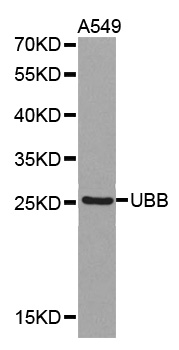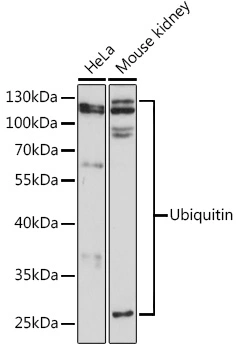![ELISA analysis of antigen using GTX60548 Ubiquitin B antibody [3C12]. Black : Control antigen 100ng Purple : Antigen 10ng Blue : Antigen 50ng Red : Antigen 100ng ELISA analysis of antigen using GTX60548 Ubiquitin B antibody [3C12]. Black : Control antigen 100ng Purple : Antigen 10ng Blue : Antigen 50ng Red : Antigen 100ng](https://www.genetex.com/upload/website/prouct_img/normal/GTX60548/GTX60548_20170912_ELISA_w_23061123_496.webp)
ELISA analysis of antigen using GTX60548 Ubiquitin B antibody [3C12]. Black : Control antigen 100ng Purple : Antigen 10ng Blue : Antigen 50ng Red : Antigen 100ng
Ubiquitin B antibody [3C12]
GTX60548
ApplicationsFlow Cytometry, Western Blot, ELISA
Product group Antibodies
TargetUBB
Overview
- SupplierGeneTex
- Product NameUbiquitin B antibody [3C12]
- Delivery Days Customer9
- Application Supplier NoteWB: 1/500 - 1/2000. FACS: 1/200 - 1/400. ELISA: 1/10000. *Optimal dilutions/concentrations should be determined by the researcher.Not tested in other applications.
- ApplicationsFlow Cytometry, Western Blot, ELISA
- CertificationResearch Use Only
- ClonalityMonoclonal
- Clone ID3C12
- Concentration1 mg/ml
- ConjugateUnconjugated
- Gene ID7314
- Target nameUBB
- Target descriptionubiquitin B
- Target synonymsHEL-S-50, polyubiquitin-B, epididymis secretory protein Li 50, polyubiquitin B
- HostMouse
- IsotypeIgG1
- Protein IDP0CG47
- Protein NamePolyubiquitin-B
- Scientific DescriptionThis gene encodes ubiquitin, one of the most conserved proteins known. Ubiquitin is required for ATP-dependent, nonlysosomal intracellular protein degradation of abnormal proteins and normal proteins with a rapid turnover. Ubiquitin is covalently bound to proteins to be degraded, and presumably labels these proteins for degradation. Ubiquitin also binds to histone H2A in actively transcribed regions but does not cause histone H2A degradation, suggesting that ubiquitin is also involved in regulation of gene expression. This gene consists of three direct repeats of the ubiquitin coding sequence with no spacer sequence. Consequently, the protein is expressed as a polyubiquitin precursor with a final amino acid after the last repeat. Aberrant form of this protein has been noticed in patients with Alzheimers and Down syndrome. [provided by RefSeq, Jul 2008]
- Storage Instruction-20°C or -80°C,2°C to 8°C
- UNSPSC12352203

![FACS analysis of HeLa cells using GTX60548 Ubiquitin B antibody [3C12]. Green : Ubiquitin B Red : negative control FACS analysis of HeLa cells using GTX60548 Ubiquitin B antibody [3C12]. Green : Ubiquitin B Red : negative control](https://www.genetex.com/upload/website/prouct_img/normal/GTX60548/GTX60548_20170912_FACS_w_23061123_844.webp)
![WB analysis of NIH3T3 (1) and HeLa (2) cell lysate using GTX60548 Ubiquitin B antibody [3C12]. WB analysis of NIH3T3 (1) and HeLa (2) cell lysate using GTX60548 Ubiquitin B antibody [3C12].](https://www.genetex.com/upload/website/prouct_img/normal/GTX60548/GTX60548_20170912_WB_1_w_23061123_597.webp)
![WB analysis of human Ubiquitin B (AA: 1-299) recombinant protein using GTX60548 Ubiquitin B antibody [3C12]. WB analysis of human Ubiquitin B (AA: 1-299) recombinant protein using GTX60548 Ubiquitin B antibody [3C12].](https://www.genetex.com/upload/website/prouct_img/normal/GTX60548/GTX60548_20170912_WB_w_23061123_714.webp)





